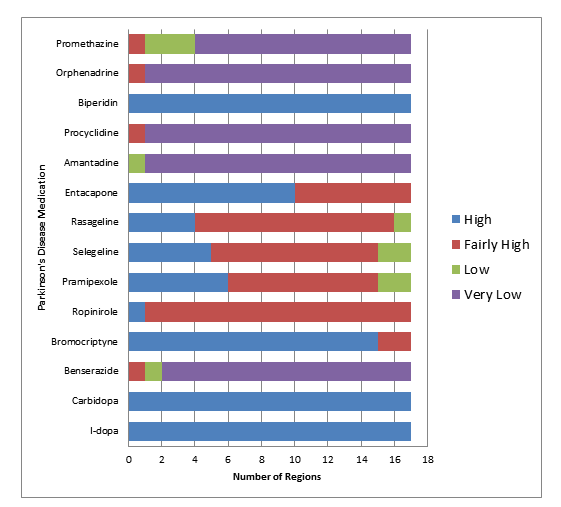Session Information
Date: Tuesday, June 6, 2017
Session Title: Therapy in Movement Disorders
Session Time: 1:45pm-3:15pm
Location: Exhibit Hall C
Objective: This study aimed to enumerate the different Parkinson’s disease medications in the Philippines and describe the distribution and availability among the 17 regions of the Philippines.
Background: Parkinson’s disease (PD) is the second most common neurodegenerative disorder and manifests as bradykinesia, rigidity, resting tremor and postural instability. In the Philippines, it is estimated that PD affects 120,000 people (or one percent of the 50-year-old and above bracket) but only 30,000 (or 25 percent) seek treatment, partly due to drug accessibility. The Philippine National Drug Formulary (PNDF) catalogues several Parkinson’s disease medications with the goals of providing accessible, efficacious, safe and affordable medicine. However, only selected Parkinson’s disease medications are included in the PNDF, leaving a large number of drug classes, not readily accessible to the general population.
Methods: This was a cross-sectional analytic study which included five major pharmacies from each Philippine region that were randomly selected. A telephone interview was done to determine availability of the different drugs.
Results: Observations revealed that all of the first-line drugs used in the treatment of Parkinson’s disease have high availability in nearly all, if not all, of the regions in the Philippines owing to high evidence of efficacy and low costs. However, most of the drugs used as adjunct treatment for Parkinson’s disease were noted to have low to very low availability in most regions in the Philippines, especially in the Visayas and Mindanao regions, due to not being part of the national drug formulary and due to high costs.
Conclusions: This study provided a glimpse of the status of PD drug availability and in the Philippines and in each of its regions. Observations revealed that all of the first-line drugs used in the treatment of Parkinson’s disease have high availability in nearly all, if not all, of the regions in the Philippines owing to high evidence of efficacy and low costs. However, most of the drugs used as adjunct treatment for Parkinson’s disease were noted to have low to very low availability in most regions in the Philippines, especially in the Visayas and Mindanao regions, due to not being part of the national drug formulary and due to high costs.
References: Gelders, S. E. (2006). Price, availability and affordability: an international comparison of chronic disease medicines.
Jolynne Mokaya RCHN1, C. L. (2016). The Accessibility of Parkinson’s Disease Medication in Kenya: Results of a National Survey. Movement Disorders Clinical Practice, 376-381.
To cite this abstract in AMA style:
S. Villaraza, C. Go. Parkinson’s Disease Medications Availability in Each Philippine Region [abstract]. Mov Disord. 2017; 32 (suppl 2). https://www.mdsabstracts.org/abstract/parkinsons-disease-medications-availability-in-each-philippine-region/. Accessed December 29, 2025.« Back to 2017 International Congress
MDS Abstracts - https://www.mdsabstracts.org/abstract/parkinsons-disease-medications-availability-in-each-philippine-region/


